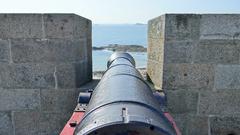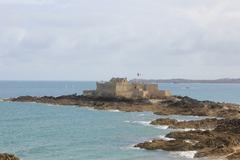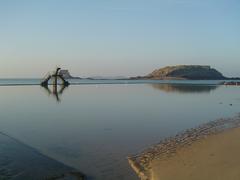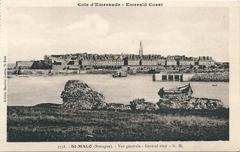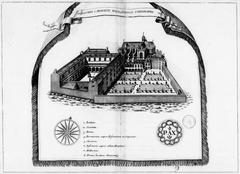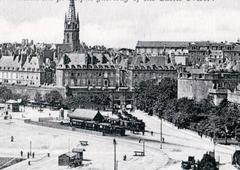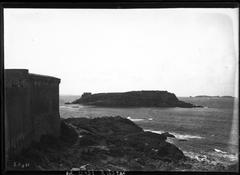Aleth Cathedral Visiting Hours, Tickets, and Complete Guide to Saint-Malo Historical Sites
Date: 04/07/2025
Introduction: Exploring Aleth Cathedral’s Legacy in Saint-Malo
Located in the historic Saint-Servan district of Saint-Malo, France, Aleth Cathedral (Cathédrale Saint-Pierre d’Aleth) stands as a remarkable symbol of Brittany’s layered religious and architectural heritage. With origins that stretch back to a Gallo-Roman settlement in the 4th century CE, through its transformation into a Merovingian and then Carolingian ecclesiastical center, Aleth Cathedral was once the bishopric’s seat before its decline in the Middle Ages. Today, its evocative ruins, preserved chapel, and sweeping views overlooking the Rance estuary and Emerald Coast make it an essential stop for history enthusiasts and travelers seeking a deeper connection to Saint-Malo’s ancient roots (Saint-Malo Tourisme, Monumentum, Wikipedia).
This comprehensive guide details everything you need to plan a memorable visit: historical context, architectural highlights, practical visitor information, accessibility notes, nearby attractions, and expert travel tips.
Historical Overview
Gallo-Roman and Early Medieval Origins
The Aleth peninsula has been continuously occupied since the Iron Age. Archaeological findings reveal that by the 4th century CE, the site hosted a prominent Gallo-Roman complex with a large courtyard and administrative buildings (Monumentum, Wikipedia).
Following the decline of Roman authority, the area evolved into a religious hub. In the Merovingian era (5th–7th centuries), a T-shaped church was established—a rare plan for Brittany. By the 9th century, a pre-Romanesque cathedral with two opposing apses, reflecting Carolingian influence, was constructed, underscoring the site’s spiritual importance (Monumentum, Wikipedia).
Episcopal Seat and Medieval Decline
Aleth became the seat of a bishopric, with its cathedral dedicated to Saint Peter. This status lasted until 1145, when the bishopric moved to Saint-Malo—attracted by its defensible location on a rocky outcrop (Spotting History). Over the following century, the cathedral and its fortifications suffered destruction during regional conflicts, with only the eastern apse surviving as a chapel (Wikipedia, Monumentum).
Rediscovery and Heritage Status
Systematic archaeological excavations in the 1970s uncovered the cathedral’s foundations and earlier structures, confirming its significance as one of Brittany’s earliest Christian worship sites. Aleth Cathedral has been a protected Monument Historique since 1945, with extended protections in 1996 (Monumentum, Regard de Corsaire).
Architectural and Archaeological Significance
Distinctive Medieval Features
The cathedral’s original layout—spanning the 10th to 12th centuries—was notable for its dual apses, square-section pillars without capitals, and the use of local granite. The eastern apse, preserved as a chapel, showcases thick stone walls and small, deep-set windows characteristic of early Romanesque architecture (POP: Plateforme ouverte du patrimoine).
Archaeological investigations have revealed stratified layers of religious, domestic, and funerary activity, including reused materials from earlier Gallo-Roman and Merovingian phases.
Comparative Context
Aleth Cathedral’s design stands apart from later Gothic structures in Brittany, such as Saint-Vincent Cathedral in Saint-Malo, and provides a rare glimpse into the transitional styles of early medieval ecclesiastical architecture in the region.
Visiting Aleth Cathedral: Practical Information
Visiting Hours
- Open daily: 9:00 AM–6:00 PM (hours may vary by season).
- Admission: Free for all visitors.
- Note: The site is outdoors and accessible year-round; check Saint-Malo Tourisme for seasonal updates.
Accessibility
- Terrain: The site has uneven ground and mild elevation; the chapel is more accessible, but the ruins may present challenges for those with limited mobility.
- Arrangements: Contact the local tourist office for specific accessibility details.
Guided Tours and Events
- Guided tours: Available seasonally, offering insights into the cathedral’s history and archaeology.
- Special events: Periodic cultural events and exhibitions highlight Brittany’s heritage. Check the official calendar in advance.
Travel Tips
- Footwear: Wear comfortable shoes.
- Photography: The ruins and estuary views offer excellent photo opportunities, especially at sunrise or sunset.
- Combine visits: Pair your trip with a stroll through Saint-Servan or explore nearby historic sites.
The Broader Cité d’Aleth: Saint-Malo’s Ancient Stronghold
Historical Context
The Cité d’Aleth is considered the birthplace of Saint-Malo, with evidence of human occupation since the Neolithic era. The peninsula was the capital of the Coriosolites (a Celtic people) and was fortified with Gallo-Roman ramparts in the 4th century CE (Saint-Malo Tourisme).
Notable Features
- Cathedral ruins: See the abside and foundations of the 10th-century cathedral.
- Gallo-Roman ramparts: Preserved defensive walls along rue Saint-Pierre.
- Vauban fortress: 17th-century military enhancements offer panoramic walking trails.
- Memorial 39-45 Museum: Located in a WWII blockhouse, presenting the area’s wartime history (St-Malo.com).
Visitor Experience
- Walking trails: The peninsula offers scenic walks with exceptional views of the bay, Rance estuary, and Dinard.
- Nearby landmarks: Tour Solidor (14th-century tower), Bas-Sablons marina, and Saint-Malo’s Intra-Muros (walled city) are within walking distance.
Visitor Information: Hours, Tickets, and Tours
- Cathedral and Cité d’Aleth: Open access year-round, free of charge.
- Memorial 39-45 Museum: Typically open April–October, with a small entrance fee; guided tours mandatory (levillageinsolite.com).
- Guided walks: Offered by local tourism offices and private guides—book in advance for the best experience.
Location and Access
- Address: Place Saint-Pierre, Saint-Servan, Saint-Malo, Brittany, France
- Getting there: A short walk from Saint-Malo’s Intra-Muros (old town) and Bas Sablons port; accessible by local bus, foot, or bicycle (saintmalowithlove.com, carnetsvanille.com).
- Parking: Available near Bas Sablons marina.
Essential Visitor Tips
- Best time to visit: Spring and summer for mild weather; early mornings and late afternoons for optimal light and fewer crowds.
- What to bring: Water, snacks, windbreaker, camera, binoculars for panoramic views.
- Facilities: Restrooms near Bas Sablons port; cafés and shops in Saint-Servan.
- Safety: Stay on marked paths and supervise children, especially near ruins and drop-offs.
Frequently Asked Questions (FAQ)
Q: What are the visiting hours for Aleth Cathedral?
A: The cathedral ruins are accessible daily from 9:00 AM to 6:00 PM, but as an open site, access may be possible outside these hours.
Q: Is there an entrance fee?
A: No, visiting the ruins is free. The Memorial 39-45 Museum charges a small fee.
Q: Are guided tours available?
A: Yes, through the Saint-Malo Tourist Office and seasonally on-site.
Q: Is the site accessible for visitors with reduced mobility?
A: The chapel is accessible, but uneven terrain and steps may be challenging elsewhere.
Q: Are there facilities for families?
A: The open-air ruins and trails are suitable for visitors of all ages, with benches and nearby amenities.
Visuals and Media
Caption: Aleth Cathedral’s evocative ruins overlooking the Rance estuary and Saint-Malo’s city walls.
Nearby Attractions
- Memorial 39-45 Museum: WWII history in an original German blockhouse (saintmalowithlove.com).
- Tour Solidor: Medieval tower and maritime museum (thalasso-saintmalo.com).
- Saint-Malo Intra-Muros: Walled city with shops, ramparts, and Saint-Vincent Cathedral.
How to Plan Your Visit
- Duration: 1–2 hours for the cathedral and peninsula; allow more for museums and historic walks.
- Combine with: Saint-Servan district stroll, Bas-Sablons marina, and Saint-Malo’s historic center.
- Guided tours: Book in advance via the Saint-Malo Tourist Office.
Summary and Recommendations
Aleth Cathedral offers a unique window into the spiritual and architectural evolution of Brittany, from its Gallo-Roman roots to its medieval prominence. The preserved ruins, especially the eastern apse, are complemented by interpretive signage, free access, and panoramic views. When paired with the broader Cité d’Aleth and nearby attractions, a visit here is both educational and visually rewarding. For a deeper experience, leverage guided tours and digital resources like the Audiala app (Saint-Malo Tourisme, POP: Plateforme ouverte du patrimoine).
Further Reading and Useful Links
- Monumentum: Aleth Cathedral Historical Listing
- POP: Plateforme ouverte du patrimoine - Aleth Cathedral
- Saint-Malo Tourisme: Cité d’Aleth Guide
- Saint-Malo Tourist Office
- Levillageinsolite.com: Cité d’Aleth
- Saintmalowithlove.com: The City of Aleth
- Carnetsvanille.com: Cité d’Aleth Walk
- Thalasso-saintmalo.com: Tourism
Stay Connected
For updates, guided tours, and exclusive audio content, download the Audiala app. Follow us on social media, and check the Saint-Malo Tourisme website for the latest news and events.
